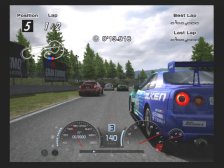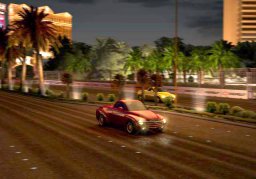Sony
and Polyphony Digitalís highly anticipated racer Gran Turismo 4 has arrived at
last for the PS2. Fortunately, it largely lives up to the exacting standards and
expectations that have built up by series regulars. GT4ís graphics are highly
polished and slick, setting a new level of realism and detail. With more than
100 unlockable during the game, thereís an incredible amount of depth. Players
will find incredibly detailed car models that ape their real-life counterparts
down to the smallest detail. While many competitors seem to have been closing
in, GT4 finds the developers once again pushing on the accelerator, and leaving
them in the dust. This is the deepest, most-realistic racer on the PS2 to date
and a must-purchase for any racing aficionado.
While many racing titles have attempted to challenge the Gran Turismo seriesí
legendary depth and realism over the years, none have ever really come close to
capturing the mystique and essence of the influential ďReal Driving
Simulator.Ē Many have aped the seriesí driving tests, extensive car lists
and realism, but few have produced as cohesive a package as Polyphony does in
seemingly effortless fashion. The long awaited arrived of GT4 for PS2 is an
event that should please fans of the series and genre, as it builds
substantially on previous installments, while not losing the essence of its
appeal. While itís not exactly perfect, GT4 is a solid upgrade that delivers
the thrilling, realistic racing action players have come to expect. As usual,
players have an extensive array of options at their disposal initially, with
several standard modes of play including
Arcade
, GT and more
available initially. There are many different modes, tons of different
challenges and loads of depth, all of which gives GT4 plenty of longevity. In
addition to the standard racing modes players have come to expect, there are a
couple of interesting twists in GT4. Thereís a director mode that allows you
to issue commands to a driver from a remote spit, such as increasing aggression
or holding back, which is quite cool. Players can also print photos from the
game in the B-Roll mode which is a nice extra, but is limited to certain
manufacturersí printers, thus hurting its usefulness.
 Players will find an
extensive array of vehicles, courses, and driving styles represented in the
game. While most of the gameís content can only be unlocked after extensive
play, the initial selection should be more than enough to satisfy gamers. The
gameís stats are impressive: it features more than 40 tracks in all ranging
from real-world racetracks, urban city driving, challenging test courses and, a
good selection of off-road rally tracks. The diversity of racing offered once
again exceeds expectations. The vehicle list is also quite impressive with more
than 40 manufacturers with more than 200 unique vehicles available in all. With
so many vehicles on offer, Polyphony has helpfully included a feature that
allows you to flag your favorites so you can find them easier later on. The
vehicles themselves range from humble economy cars, to sedans, to high-end
sports cars, rally cars, prototypes, and super-high end vehicles. This gives the
game plenty of balance and offers a wide variety of driving experiences and
techniques to master. Most major manufacturers are included with vehicles from
Toyota, Mazda, Honda, Subaru, Nissan, Hyundai, Suzuki, Daihatsu, and others
representing the Asian market. A impressive number of American models such as
Ford, Buick, Cadillac, Dodge, Chevrolet, and Pontiac are also represented.
European modes from Audi, Peugot, BMW, Jaguar, Volkswagen and, Volvo are also
included. In addition to these mainstream models, players will find numerous
vehicles from more obscure manufacturers including exotics from Alfa Romeo,
Aston Martin, Opel, Pagani,
Shelby
, Scion, plus many
other vanity and boutique models. Thereís an extensive selection of model
years as well, with many classic vehicles from the 1950ís on available along
with the expected inclusion of todayís performance beasts. You can find these
classic vehicles within manufacturer pages or grouped together by era. While the
manufacturers are heavily weighted towards Japanese firms, other areas of the
world are represented with many American and European models available.
Players will find an
extensive array of vehicles, courses, and driving styles represented in the
game. While most of the gameís content can only be unlocked after extensive
play, the initial selection should be more than enough to satisfy gamers. The
gameís stats are impressive: it features more than 40 tracks in all ranging
from real-world racetracks, urban city driving, challenging test courses and, a
good selection of off-road rally tracks. The diversity of racing offered once
again exceeds expectations. The vehicle list is also quite impressive with more
than 40 manufacturers with more than 200 unique vehicles available in all. With
so many vehicles on offer, Polyphony has helpfully included a feature that
allows you to flag your favorites so you can find them easier later on. The
vehicles themselves range from humble economy cars, to sedans, to high-end
sports cars, rally cars, prototypes, and super-high end vehicles. This gives the
game plenty of balance and offers a wide variety of driving experiences and
techniques to master. Most major manufacturers are included with vehicles from
Toyota, Mazda, Honda, Subaru, Nissan, Hyundai, Suzuki, Daihatsu, and others
representing the Asian market. A impressive number of American models such as
Ford, Buick, Cadillac, Dodge, Chevrolet, and Pontiac are also represented.
European modes from Audi, Peugot, BMW, Jaguar, Volkswagen and, Volvo are also
included. In addition to these mainstream models, players will find numerous
vehicles from more obscure manufacturers including exotics from Alfa Romeo,
Aston Martin, Opel, Pagani,
Shelby
, Scion, plus many
other vanity and boutique models. Thereís an extensive selection of model
years as well, with many classic vehicles from the 1950ís on available along
with the expected inclusion of todayís performance beasts. You can find these
classic vehicles within manufacturer pages or grouped together by era. While the
manufacturers are heavily weighted towards Japanese firms, other areas of the
world are represented with many American and European models available.
 Players
who want to get right into the action can select Arcade Mode, where they can
choose a car and track and begin their quest. This mde allows you immediate
access to high-end vehicles, race cars and other high-end vehicles. However,
donít be fooled, since the Arcade mode also requires exacting driving
standards, and isnít as simple as you might expect. The driversí AI is quite
high here, and you probably wonít win many races without much practice.
However, you can still earn GT points, which you can use to purchase vehicles
and other items in this mode. While the arcade mode is fun and makes a nice
breather for those in the heat of GT mode, it doesnít have the depth,
customization or selection and serves mainly as a pleasing extra. The main meat
of the game lies in its extensive GT Mode, where you have a chance to build up a
career by winning races and upgrading your vehicle. In this mode, players can
view the cars in their garage and choose whether to buy or sell them. There are
also several dealerships which sell various types of cars, and parts shops where
you can buy upgrades for your vehicle. In addition, players can buy and sell
cars as they progress through the ranks. As usual, players can also choose to
race against a set group of opponents and parameters on the main tracks, or in
specialized races against cars of the same class. At first, youíre limited to
a few events, but can unlock more by winning races and purchasing additional
vehicles. You select which racing events to compete in and can earn money
depending on your finishing position. In the main menu, most races are grouped
by nation, with separate areas fro Japanese, European and American cars to name
a few. Players can also select different event types such as Beginner Challenges
and Special Events as well. Each racing type or nation requires the player to
have the appropriate car or license to compete. Players will find that
navigation of the GT mode is simple, just point the cursor over the area you
want to go. While progression in this mode is fairly slow, at least initially,
persistence pays off once you begin to upgrade your less-desirable vehicles, win
races and trade in for more powerful cars later on. It seems intimidating, but
this mode is required if you really want to get the most out of the game.
Players
who want to get right into the action can select Arcade Mode, where they can
choose a car and track and begin their quest. This mde allows you immediate
access to high-end vehicles, race cars and other high-end vehicles. However,
donít be fooled, since the Arcade mode also requires exacting driving
standards, and isnít as simple as you might expect. The driversí AI is quite
high here, and you probably wonít win many races without much practice.
However, you can still earn GT points, which you can use to purchase vehicles
and other items in this mode. While the arcade mode is fun and makes a nice
breather for those in the heat of GT mode, it doesnít have the depth,
customization or selection and serves mainly as a pleasing extra. The main meat
of the game lies in its extensive GT Mode, where you have a chance to build up a
career by winning races and upgrading your vehicle. In this mode, players can
view the cars in their garage and choose whether to buy or sell them. There are
also several dealerships which sell various types of cars, and parts shops where
you can buy upgrades for your vehicle. In addition, players can buy and sell
cars as they progress through the ranks. As usual, players can also choose to
race against a set group of opponents and parameters on the main tracks, or in
specialized races against cars of the same class. At first, youíre limited to
a few events, but can unlock more by winning races and purchasing additional
vehicles. You select which racing events to compete in and can earn money
depending on your finishing position. In the main menu, most races are grouped
by nation, with separate areas fro Japanese, European and American cars to name
a few. Players can also select different event types such as Beginner Challenges
and Special Events as well. Each racing type or nation requires the player to
have the appropriate car or license to compete. Players will find that
navigation of the GT mode is simple, just point the cursor over the area you
want to go. While progression in this mode is fairly slow, at least initially,
persistence pays off once you begin to upgrade your less-desirable vehicles, win
races and trade in for more powerful cars later on. It seems intimidating, but
this mode is required if you really want to get the most out of the game.
GT
mode also features the infamous and somewhat dreaded licensing modes, where you
have to pass a series of exacting, sometimes frustrating driving tests. Some of
these tests seem deceptively simple, but the structure leaves little room for
error. Many of the earlier tests require you to perform simple tasks such as
accelerating and braking, while the more advanced tests require you to take
devastating corners without skidding off the runway. The thing here is that
youíll need a great deal of patience, since many will take multiple attempts
to beat. This is really frustrating when you find yourself a few tenths of a
second off the mark, missing the test requirements by a small margin. While they
can be a bit tedious after awhile, the techniques you learn in the licensing
area help to improve your driving skills. After you pass each test you move on
to the next one. Each license requires you to pass 16 tests but once youíve
earned a license class, youíll unlock a series of races and can use any of
your earned money or points to buy additional vehicles.
This formula hasnít changed much from the first GT game, and really
works well for a simulation. It not only tests your driving skills effectively,
but works well in demonstrating Polyphonyís rigorous attention to detail and
authenticity.
 Once
youíve mastered the basics, itís time to hit the pavement and find out what
youíre really made of. With such a large number of vehicles in the game, you
could forgive Polyphony if many of the cars performed similarly, but they
donít. Each car in GT4 has a unique feel with little nuances that make their
performance and handling differ. While the kludgy steering, poor acceleration
and sub-par cornering of the beginner vehicles is frustrating, more advanced
vehicles can be difficult to control, with over-steering and cornering
techniques very difficult to master. The game controls are about as fluid and
intuitive as one could expect, with steering, accelerating and braking simply
mapped to the PS2ís standard controller. The responsiveness and realistic
performance of each vehicle makes driving each one about as close to perfection
as one could ask for, making for one of the smoothest driving experiences on the
PS2 to date. Players can also set numerous options on the fly, with multiple
viewpoints easily selectable. In certain training levels, you can also toggle a
roadside guide on and off. This is extremely helpful when you canít quite
figure out which racing lines to take and where you need to begin your braking
before tight corners. Unfortunately, we werenít able to test the game with one
of the high-end steering controllers on the market, but its safe to assume that
GT4 plays even better with one of these devices.
Once
youíve mastered the basics, itís time to hit the pavement and find out what
youíre really made of. With such a large number of vehicles in the game, you
could forgive Polyphony if many of the cars performed similarly, but they
donít. Each car in GT4 has a unique feel with little nuances that make their
performance and handling differ. While the kludgy steering, poor acceleration
and sub-par cornering of the beginner vehicles is frustrating, more advanced
vehicles can be difficult to control, with over-steering and cornering
techniques very difficult to master. The game controls are about as fluid and
intuitive as one could expect, with steering, accelerating and braking simply
mapped to the PS2ís standard controller. The responsiveness and realistic
performance of each vehicle makes driving each one about as close to perfection
as one could ask for, making for one of the smoothest driving experiences on the
PS2 to date. Players can also set numerous options on the fly, with multiple
viewpoints easily selectable. In certain training levels, you can also toggle a
roadside guide on and off. This is extremely helpful when you canít quite
figure out which racing lines to take and where you need to begin your braking
before tight corners. Unfortunately, we werenít able to test the game with one
of the high-end steering controllers on the market, but its safe to assume that
GT4 plays even better with one of these devices.
Another key element that separates Gran Turismo 4 from most other titles on the
market is its attention to detail and authenticity. For example, the performance
enhancements of adding different tires to vehicles in other games causes barely
a ripple, in GT4 it can make all the difference in the way a car handles curves,
or its traction on rough surfaces. Players will find numerous extra parts for
each vehicle, and knowing when to use them, and where to use them makes all the
difference. Upgrading your engine, reducing your vehicleís weight or revamping
the steering columns can make a huge difference, enabling even a humble, low-end
vehicle to experience significant performance improvements. Of course, you can
only do so much with certain vehicles, and there comes points when you have to
trade or sell them for cars that are more sophisticated and complex. Whatís
most impressive about all of this is that the game gradually opens up as you
progress, slowly inching you towards more advanced, yet sophisticated vehicles
as you go along. This measured approach to racing is definitely the seriesí
trademark, and those looking for a quick spin are bound to be disappointed Ė
it takes quite some time to master the gameís intricacies and nuances.
Thereís quite a time commitment involved, those who have the patience will
find a genuinely rewarding and deep experience, while gamers looking for a quick
fix will probably find the gameís simulation aspects too dry for their tastes.
 From
a visual standpoint, Gran Turismo 4 sets another high-water mark for the series.
As youíd expect, plenty of attention has been placed on the car models, which
are spectacularly realistic. The carsí bodies and appearance is about as close
to reality as youíre likely to find, with natural reflections and beautiful
finishes making each vehicle shine. The vehicles still donít take damage, but
this is a minor issue at this point since most GT fans have come to expect it.
The sheer number of cars is impressive and the level of detail in each is quite
astonishing. GT4ís courses and environments also look quite impressive,
particularly some of the outdoors and off-track courses, such as the
Grand Canyon
track, which looks breathtakingly lifelike,
with impressive vistas and an extensive line of view. The sheer diversity and
quality of courses gives the player quite a varied experience, making GT4 feel
like several games in one package. Each of these environments features a variety
of impressive weather and other effects such as rain, snow and times of day.
Each course showcases a tremendous amount of detail, which adds to the gameís
realism. The developers have also spend time making the road-side spectators
seem more lifelike. No longer are they pasted on digitized characters, and are
actually 3D modeled characters react quickly and jump out of the way when your
vehicle goes outside the railings. Unfortunately, the graphics engine is a bit
buggy, and certain areas tend to glitch and freeze up slightly at certain
points, which is surprising given the amount of polish thatís gone into GT4.
Still, this remains the most impressive racing title on the PS2 to date,
offering a level of realism that no other title on the platform has yet matched.
From
a visual standpoint, Gran Turismo 4 sets another high-water mark for the series.
As youíd expect, plenty of attention has been placed on the car models, which
are spectacularly realistic. The carsí bodies and appearance is about as close
to reality as youíre likely to find, with natural reflections and beautiful
finishes making each vehicle shine. The vehicles still donít take damage, but
this is a minor issue at this point since most GT fans have come to expect it.
The sheer number of cars is impressive and the level of detail in each is quite
astonishing. GT4ís courses and environments also look quite impressive,
particularly some of the outdoors and off-track courses, such as the
Grand Canyon
track, which looks breathtakingly lifelike,
with impressive vistas and an extensive line of view. The sheer diversity and
quality of courses gives the player quite a varied experience, making GT4 feel
like several games in one package. Each of these environments features a variety
of impressive weather and other effects such as rain, snow and times of day.
Each course showcases a tremendous amount of detail, which adds to the gameís
realism. The developers have also spend time making the road-side spectators
seem more lifelike. No longer are they pasted on digitized characters, and are
actually 3D modeled characters react quickly and jump out of the way when your
vehicle goes outside the railings. Unfortunately, the graphics engine is a bit
buggy, and certain areas tend to glitch and freeze up slightly at certain
points, which is surprising given the amount of polish thatís gone into GT4.
Still, this remains the most impressive racing title on the PS2 to date,
offering a level of realism that no other title on the platform has yet matched.
Overall, Gran Turismo 4 offers exactly what players have come to expect from the
series: a highly-tuned precision driving simulator thatís demanding and deep.
The gameplay is standard GT with hundreds of vehicles, many driving types and
the extensive GT mode that offers the typically deep RPG-like racing experience.
The sheer number of cars, vehicles and courses can be overwhelming, so its best
to take this on in small chunks. While there are a few interesting twists such
as the new direction mode, GT4 stays largely true to the seriesí formula to
date. Some players will find the experience frustrating and too technical, those
who really want a deep driving simulator have come to the right place. From an
aesthetic standpoint, the game truly pushes the PS2 hardware to its limits,
creating the most realistic racing game on the platform to date. Gran Turismo 4
represents the pinnacle of the genre, and marks another high-water mark for the
franchise.

